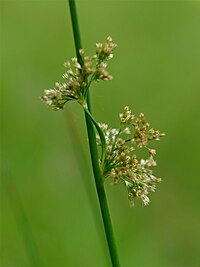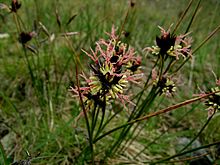Juncus
| Juncus | |
|---|---|

| |
| Habit of J. conglomeratus | |

| |
| Flower of J. squarrosus showing: 6 spreading tepals, anthers (upright yellow, held on white filaments), ovary (green) with stigma (pinkish tip column) and styles (white) | |
| Scientific classification | |
| Kingdom: | Plantae |
| Clade: | Tracheophytes |
| Clade: | Angiosperms |
| Clade: | Monocots |
| Clade: | Commelinids |
| Order: | Poales |
| Family: | Juncaceae |
| Genus: | Juncus L. |
| Type species | |
| Juncus acutus | |
| Synonyms[1] | |
| |
Juncus is a genus of monocotyledonous flowering plants, commonly known as rushes. It is the largest genus in the family Juncaceae, containing around 300 species.[2]
Description
Rushes of the genus Juncus are
The form of the flower differentiates rushes from grasses or sedges. The flowers of Juncus comprise five
In Juncus section Juncotypus (formerly called Juncus subg. Genuini),[6] which contains some of the most widespread and familiar species, the leaves are reduced to sheaths around the base of the stem and the bract subtending the inflorescence closely resembles a continuation of the stem, giving the appearance that the inflorescence is lateral.[7]
Distribution and ecology
Juncus has a
Fossil record
Several
Classification

The genus Juncus was first named by
The genus is divided into the following subgenera and sections:[6]
- Juncus subg. Juncus
- sect. Juncus
- sect. Graminei (Engelm.) Engelm.
- sect. Caespitosi Cout.
- sect. Stygiopsis Kuntze
- sect. Ozophyllum Dumort.
- sect. Iridifolii Snogerup & Kirschner
- Juncus subg. Poiophylli Buchenau
- sect. Tenageia Dumort.
- sect. Steirochloa Griseb.
- sect. Juncotypus Dumort.
- sect. Forskalina Kuntze
Species
Plants of the World Online accepts the following species in the genus Juncus:[9]
- Juncus acuminatus Michx.
- Juncus acutiflorus Ehrh. ex Hoffm.
- Juncus acutus L.
- Juncus aemulans Liebm.
- Juncus alatus Franch. & Sav.
- Juncus alexandri L.A.S.Johnson
- Juncus allioides Franch.
- Juncus alpigenus K.Koch
- Juncus × alpiniformis Fernald
- Juncus alpinoarticulatus Chaix
- Juncus amabilis Edgar
- Juncus amplifolius A.Camus
- Juncus amuricus (Maxim.) V.I.Krecz. & Gontsch.
- Juncus anatolicus Snogerup
- Juncus anceps Laharpe
- Juncus andersonii Buchenau
- Juncus andinus Balslev
- Juncus antarcticus Hook.f.
- Juncus anthelatus (Wiegand) R.E.Brooks & Whittem.
- Juncus arcticus Willd.
- Juncus aridicola L.A.S.Johnson
- Juncus articulatus L.
- Juncus astreptus L.A.S.Johnson
- Juncus atratus Krock.
- Juncus australis Hook.f.
- Juncus austrobrasiliensis Balslev
- Juncus baekdusanensis M.Kim
- Juncus balticus Willd.
- Juncus bassianus L.A.S.Johnson
- Juncus batrachium Veldkamp
- Juncus benghalensis Kunth
- Juncus beringensis Buchenau
- Juncus biflorus Elliott
- Juncus biglumis L.
- Juncus biglumoides H.Hara
- Juncus bolanderi Engelm.
- Juncus brachycarpus Engelm.
- Juncus brachycephalus (Engelm.) Buchenau
- Juncus brachyphyllus Wiegand
- Juncus brachyspathus Maxim.
- Juncus brachystigma Sam.
- Juncus brasiliensis Breistr.
- Juncus brevibracteus L.A.S.Johnson
- Juncus brevicaudatus(Engelm.) Fernald
- Juncus breviculmis Balslev
- Juncus breweri Engelm.
- Juncus × brueggeri Domin
- Juncus bryoides F.J.Herm.
- Juncus bryophilus W.W.Sm.
- Juncus bufonius L.
- Juncus bulbosus L.
- Juncus burkartii Barros
- Juncus caesariensis Coville
- Juncus caespiticius E.Mey.
- Juncus canadensis J.Gay ex Laharpe
- Juncus capensis Thunb.
- Juncus capillaceus Lam.
- Juncus capillaris F.J.Herm.
- Juncus capitatus Weigel
- Juncus castaneus Sm.
- Juncus cephalostigma Sam.
- Juncus cephalotes Thunb.
- Juncus chiapasensis Balslev
- Juncus chlorocephalus Engelm.
- Juncus chrysocarpus Buchenau
- Juncus clarkei Buchenau
- Juncus compressus Jacq.
- Juncus concinnus D.Don
- Juncus concolor Sam.
- Juncus confusus Coville
- Juncus conglomeratus L.
- Juncus continuus L.A.S.Johnson
- Juncus cooperi Engelm.
- Juncus cordobensis Barros
- Juncus coriaceus Mack.
- Juncus × correctus Steud.
- Juncus covillei Piper
- Juncus crassistylus A.Camus
- Juncus curtisiae L.A.S.Johnson
- Juncus curvatus Buchenau
- Juncus cyperoides Laharpe
- Juncus debilis A.Gray
- Juncus decipiens (Buchenau) Nakai
- Juncus × degenianus Boros
- Juncus densiflorus Kunth
- Juncus deosaicus Noltie
- Juncus diastrophanthus Buchenau
- Juncus dichotomus Elliott
- Juncus diemii Barros
- Juncus diffusissimus Buckley
- Juncus × diffusus Hoppe
- Juncus digitatus C.W.Witham & Zika
- Juncus distegus Edgar
- Juncus dolichanthus L.A.S.Johnson
- Juncus dongchuanensis K.F.Wu
- Juncus × donyanae Fern.-Carv.
- Juncus dregeanus Kunth
- Juncus drummondii E.Mey.
- Juncus dubius Engelm.
- Juncus dudleyi Wiegand
- Juncus dulongjiongensis Novikov
- Juncus durus L.A.S.Johnson & K.L.Wilson
- Juncus duthiei (C.B.Clarke) Noltie
- Juncus ebracteatus E.Mey.
- Juncus echinocephalus Balslev
- Juncus ecuadoriensis Balslev
- Juncus edgariae L.A.S.Johnson & K.L.Wilson
- Juncus effusus L.
- Juncus elbrusicus Galushko
- Juncus elliottii Chapm.
- Juncus emmanuelis A.Fern. & J.G.García
- Juncus engleri Buchenau
- Juncus ensifolius Wikstr.
- Juncus equisetinus Proskur.
- Juncus ernesti-barrosi Barros
- Juncus exiguus (Fernald & Wiegand) Lint ex Snogerup & P.F.Zika
- Juncus exsertus Buchenau
- Juncus falcatus E.Mey.
- Juncus × fallax Trab.
- Juncus fascinatus (M.C.Johnst.) W.M.Knapp
- Juncus fauriei H.Lév. & Vaniot
- Juncus fauriensis Buchenau
- Juncus fernandez-carvajaliae Romero Zarco & Arán
- Juncus filicaulis Buchenau
- Juncus filiformis L.
- Juncus filipendulus Buckley
- Juncus fimbristyloides Noltie
- Juncus firmus L.A.S.Johnson
- Juncus flavidus L.A.S.Johnson
- Juncus fockei Buchenau
- Juncus foliosus Desf.
- Juncus fominii Zoz
- Juncus fontanesii J.Gay ex Laharpe
- Juncus fugongensis S.Y.Bao
- Juncus × fulvescens Fernald
- Juncus ganeshii Miyam. & H.Ohba
- Juncus georgianus Coville
- Juncus gerardiLoisel.
- Juncus giganteus Sam.
- Juncus glaucoturgidus Noltie
- Juncus gonggae Miyam. & H.Ohba
- Juncus × gracilescens F.J.Herm. ex Wadmond
- Juncus gracilicaulis A.Camus
- Juncus gracillimus (Buchenau) V.I.Krecz. & Gontsch.
- Juncus greenei Oakes & Tuck.
- Juncus gregiflorus L.A.S.Johnson
- Juncus grisebachii Buchenau
- Juncus guadeloupensis Buchenau & Urb.
- Juncus gubanovii Novikov
- Juncus gymnocarpus Coville
- Juncus haenkei E.Mey.
- Juncus hallii Engelm.
- Juncus harae Miyam. & H.Ohba
- Juncus heldreichianus T.Marsson ex Parl.
- Juncus hemiendytus F.J.Herm.
- Juncus heptopotamicus V.I.Krecz. & Gontsch.
- Juncus hesperius (Piper) Lint
- Juncus heterophyllus Dufour
- Juncus himalensis Klotzsch
- Juncus holoschoenus R.Br.
- Juncus homalocaulis F.Muell. ex Benth.
- Juncus howellii F.J.Herm.
- Juncus hybridus Brot.
- Juncus hydrophilus Noltie
- Juncus imbricatus Laharpe
- Juncus inflexus L.
- Juncus ingens N.A.Wakef.
- Juncus interior Wiegand
- Juncus × inundatus Drejer
- Juncus jacquinii L.
- Juncus jaxarticus V.I.Krecz. & Gontsch.
- Juncus jinpingensis S.Y.Bao
- Juncus kelloggii Engelm.
- Juncus khasiensis Buchenau
- Juncus kingii Rendle
- Juncus kleinii Barros
- Juncus krameri Franch. & Sav.
- Juncus kraussii Hochst.
- Juncus kuohii M.J.Jung
- Juncus laccatus P.F.Zika
- Juncus laeviusculus L.A.S.Johnson
- Juncus lancangensis Y.Y.Qian
- Juncus × langii Erdner
- Juncus leiospermus F.J.Herm.
- Juncus × lemieuxii B.Boivin
- Juncus leptospermus Buchenau
- Juncus lesueurii Bol.
- Juncus leucanthus Royle ex D.Don
- Juncus leucomelas Royle ex D.Don
- Juncus liebmannii J.F.Macbr.
- Juncus littoralis C.A.Mey.
- Juncus llanquihuensis Barros
- Juncus lomatophyllus Spreng.
- Juncus longiflorus (A.Camus) Noltie
- Juncus longii Fernald
- Juncus longirostris Kuvaev
- Juncus longistamineus A.Camus
- Juncus longistylis Torr.
- Juncus luciensis Ertter
- Juncus luzuliformis Franch.
- Juncus macrandrus Coville
- Juncus macrantherus V.I.Krecz. & Gontsch.
- Juncus macrophyllus Coville
- Juncus marginatus Rostk.
- Juncus maritimus Lam.
- Juncus maroccanus Kirschner
- Juncus maximowiczii Buchenau
- Juncus megacephalus M.A.Curtis
- Juncus megalophyllus S.Y.Bao
- Juncus meianthus L.A.S.Johnson ex K.L.Wilson
- Juncus membranaceus Royle
- Juncus mertensianus Bong.
- Juncus micranthus Schrad. ex E.Mey.
- Juncus microcephalus Kunth
- Juncus milashanensis A.M.Lu & Z.Y.Zhang
- Juncus militaris Bigelow
- Juncus minimus Buchenau
- Juncus minutulus (Albert & Jahand.) Prain
- Juncus modicus N.E.Br.
- Juncus mollis L.A.S.Johnson
- Juncus × montellii Vierh.
- Juncus × montserratensis Marcet
- Juncus × murbeckii Sagorski
- Juncus mustangensis Miyam. & H.Ohba
- Juncus nepalicus Miyam. & H.Ohba
- Juncus nevadensis S.Watson
- Juncus nodatus Coville
- Juncus × nodosiformis Fernald
- Juncus nodosus L.
- Juncus novae-zelandiae Hook.f.
- Juncus nupela Veldkamp
- Juncus obliquus Adamson
- Juncus × obotritorum Rothm.
- Juncus occidentalis Wiegand
- Juncus ochraceus Buchenau
- Juncus ochrocoleus L.A.S.Johnson
- Juncus orchonicus Novikov
- Juncus × oronensis Fernald
- Juncus orthophyllus Coville
- Juncus oxycarpus E.Mey. ex Kunth
- Juncus oxymeris Engelm.
- Juncus pallescens Lam.
- Juncus pallidus R.Br.
- Juncus paludosus E.L.Bridges & Orzell
- Juncus papillosus Franch. & Sav.
- Juncus parryi Engelm.
- Juncus patens E.Mey.
- Juncus pauciflorus R.Br.
- Juncus pelocarpus E.Mey.
- Juncus perpusillus Sam.
- Juncus persicus Boiss.
- Juncus pervetus Fernald
- Juncus petrophilus Miyam.
- Juncus phaeanthus L.A.S.Johnson
- Juncus phaeocephalus Engelm.
- Juncus pictus Steud.
- Juncus planifolius R.Br.
- Juncus polyanthemus Buchenau
- Juncus polycephalus Michx.
- Juncus potaninii Buchenau
- Juncus prismatocarpus R.Br.
- Juncus procerus E.Mey.
- Juncus prominens (Buchenau) Miyabe & Kudô
- Juncus przewalskii Buchenau
- Juncus psammophilus L.A.S.Johnson
- Juncus punctorius L.f.
- Juncus pusillus Buchenau
- Juncus pygmaeus Rich. ex Thuill.
- Juncus pylaei Laharpe
- Juncus radula Buchenau
- Juncus ramboi Barros
- Juncus ranarius Songeon & E.P.Perrier
- Juncus ratkowskyanus L.A.S.Johnson
- Juncus rechingeri Snogerup
- Juncus regelii Buchenau
- Juncus remotiflorus L.A.S.Johnson
- Juncus repens Michx.
- Juncus requienii Parl.
- Juncus revolutus R.Br.
- Juncus rigidus Desf.
- Juncus roemerianus Scheele
- Juncus rohtangensis Goel & Aswal
- Juncus × ruhmeri Asch. & Graebn.
- Juncus rupestris Kunth
- Juncus × sallandiae Corporaal & Schaminée
- Juncus salsuginosus Turcz. ex C.A.Mey.
- Juncus sandwithii Lourteig
- Juncus sarophorus L.A.S.Johnson
- Juncus saximontanus A.Nelson
- Juncus scabriusculus Kunth
- Juncus scheuchzerioides Gaudich.
- Juncus scirpoides Lam.
- Juncus secundus P.Beauv. ex Poir.
- Juncus semisolidus L.A.S.Johnson
- Juncus setchuensis Buchenau
- Juncus sherei Miyam. & H.Ohba
- Juncus sikkimensis Hook.f.
- Juncus socotranus (Buchenau) Snogerup
- Juncus sonderianus Buchenau
- Juncus soranthus Schrenk
- Juncus sorrentinoi Parl.
- Juncus sparganiifolius Boiss. & Kotschy ex Buchenau
- Juncus spectabilis Rendle
- Juncus sphacelatus Decne.
- Juncus sphaerocarpus Nees
- Juncus spumosus Noltie
- Juncus squarrosus L.
- Juncus stenopetalus Adamson
- Juncus stipulatus Nees & Meyen
- Juncus striatus Schousb. ex E.Mey.
- Juncus × stuckeyi Reinking
- Juncus stygius L.
- Juncus subcaudatus (Engelm.) Coville & S.F.Blake
- Juncus subglaucus L.A.S.Johnson
- Juncus subnodulosus Schrank
- Juncus subsecundus N.A.Wakef.
- Juncus subtilis E.Mey.
- Juncus subulatus Forssk.
- Juncus subulitepalus Balslev
- Juncus supiniformis Engelm.
- Juncus taonanensis Satake & Kitag.
- Juncus tenageia Ehrh. ex L.f.
- Juncus tenuis Willd.
- Juncus texanus (Engelm.) Coville
- Juncus textilis Buchenau
- Juncus thomasii Ten.
- Juncus thompsonianus L.A.S.Johnson
- Juncus thomsonii Buchenau
- Juncus tiehmii Ertter
- Juncus tingitanus Maire & Weiller
- Juncus tobdeniorum Noltie
- Juncus torreyi Coville
- Juncus trachyphyllus Miyam. & H.Ohba
- Juncus trichophyllus W.W.Sm.
- Juncus triformis Engelm.
- Juncus triglumis L.
- Juncus trigonocarpus Steud.
- Juncus trilocularis Zika
- Juncus turkestanicus V.I.Krecz. & Gontsch.
- Juncus uncialis Greene
- Juncus uniflorus W.W.Sm.
- Juncus uruguensis Griseb.
- Juncus usitatus L.A.S.Johnson
- Juncus vaginatus R.Br.
- Juncus × valbrayi H.Lév.
- Juncus validus Coville
- Juncus valvatus Link
- Juncus vaseyi Engelm.
- Juncus venturianus Castillón
- Juncus virens Buchenau
- Juncus wallichianus J.Gay ex Laharpe
- Juncus xiphioides E.Mey.
- Juncus yui S.Y.Bao
References
- ^ Kew World Checklist of Selected Plant Families
- ^ ISBN 0-19-513729-9.
- ^ a b c d D. M. D. Yakandawala; U. M. Sirisena; M. D. Dassanayake (2005). "Two new records of Juncus species (rush family – Juncaceae) in Sri Lanka" (PDF). Ceylon Journal of Science. 33: 67–76.
- .
- ISBN 978-0-19-515207-4.
- ^ S2CID 31779452.
- .
- ^ Angiosperm Fruits and Seeds from the Middle Miocene of Jutland (Denmark) by Else Marie Friis, The Royal Danish Academy of Sciences and Letters 24:3, 1985
- ^ "Juncus L." Plants of the World Online. Board of Trustees of the Royal Botanic Gardens, Kew. 2017. Retrieved 22 January 2021.




